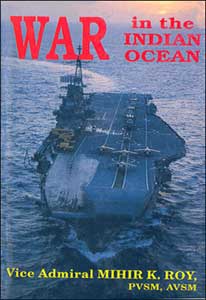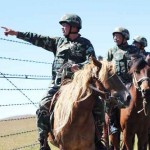MV Chitrangada, which was a slower vessel, was sailed at about 2300 hours on 7 December 1971. The rest of the force departed Hasnabad on 7 December 1971 and effected a rendezvous by about 1630 hours on the same day despite a Pakistani WIT station breaking in on the Calcutta naval frequency and instructing Panvel to transmit continuously in order to obtain an accurate intercept bearing. The entire force arrived, without opposition, at Akram Point after midnight. Panvel picked up two medium contacts on her rdar of ships leaving harbour at speeds superior to Force Alpha. The message was relayed to the Eastern Fleet (Rear Admiral S. H. Sharma) flying his flag on board the aircraft carrier Vikrant. The Pakistani freighters Anwar Baksh and Baqir were intercepted and became prizes of war. Force Alpha continued to remain at Akram Point.
Palash was also set on fire but was able to beach on the Eastern shore. Panvel manoeuvred to escape the air attack. Some of the crew of the vessels that were hit jumped into the water.
The Force again got underway at 1500 hours on 9 December to arrive at Mongla by about 2300 hours as most of the channel buoys remained lit. However, about 2 km from Mongla, they saw the anchorage ablaze. Hence, they anchored for the night and entered Mongla harbour at first light on 10 December, Four medium-sized merchantmen, Mastrostellos (earlier mined in the channel), Rigoletto, Nordpole and a foreign freighter were in flames. The Somalian vessel, Lightning, which was attacked in August, was lying alongside the Khulna Shipyard jetty. The Pakistani merchantman, Makran, was masquerading as MV Dora. The Ocean Enterprise also changed its name to the Panamian ship Clandente. They were both boarded. Ansar and the mooring vessel Mahir were also seized. MV Chitrangada remained behind to render assistance as also search for survivors. Panvel, Padma and Palash sailed on to Khulna. They were loudly cheered by the local villagers lining the banks and responding to the throaty cry of ‘Joy Bangia’.
Khulna surrenders to Force Alpha
Force Alpha entered the port of Khulna at about 1130 hours and manoeuvred close to the Western shore which was in the centre of the city. At about 1140 hours, three IAF Gnats were sighted and the yellow identification flag on all the vessels was prominently displayed. However, the Gnats dived to attack Padma which was disabled. Palash was also set on fire but was able to beach on the Eastern shore. Panvel manoeuvred to escape the air attack. Some of the crew of the vessels that were hit jumped into the water. They were in turn fired upon by Pakistani forces. Panvel closed the stricken ships and opened fire at the miscreants with 40/60 Bofors and LMGs. The local population watching the naval action from the opposite shore cheered lustily as Pakistani soldiers retreated. This was more like a bullfight than war at sea! However, at 1240 hours, a second attack by three Gnats developed. Fortunately they recognized the yellow flag just in time and instead straffed the Khulna shipyard, steel mills and government offices.
Lieutenant S.K. Mitra and Sub-Lieutenant Bandopadhya of the Indian Navy were captured by the Pakistani forces. They were treated well in custody as the liberation forces were fast approaching and were subsequently released. The officers rejoined the ship and both rose to the rank of Commander. The dead included 5 Mukti Bahini naval personal, 2 Mukti Bahini guides, 1 Lance Naik of BSF and 3 Indian naval personnel. 7 others received minor injuries.
| Also read: |
Panvel and Chitrangada embarked the casualities and returned to Hasnabad by 1800 hours on 18 December. The wounded and dead were transferred to the Barrackpore Military Hospital. Within days the Pakistan Army surrendered and Bangladesh was born. Commander Samant, Lieutenant Commander Noronah and Leading Seaman C. Singh were awarded the Maha Vir Chakra. Vir Chakras were awarded to five others. So ended the remarkable conflict in inland waters with 400 Mukti Bahini frogmen sinking or damaging over a lakh tons of shipping in the embayed Indian Ocean. And yet this saga of courage and achievement lies buried and unreported even after a quarter of a century – an unsung epitaph to the sacrifice and determination of the sons of Bangladesh.
Epilogue
The Mukti Bahini guerrillas had done their duty by inflicting a crippling damage on the East Pakistan ports, inland waterways and shipping. In toting up this score, which had since been confirmed by Lloyd’s with minor discrepancies, one has to view not only the sinking of ships or damage to jetties and immobilization of ports and navigable channels but also to the vast amount of international shipping that kept away from East Bengal ports in spite of the high rates of compensation announced by the Government. The Mukti Bahini frogmen I held East Pakistan in a state of siege in the highest traditions , of war at sea and that too without possessing a single oceangoing I vessel.
the frogmen attained their aim of closing the major ports of Chalna/Mongla and Chittagong, which paradoxically was mined by the departing Pakistani authorities using Chinese fabricated mines almost on the day prior to the surrender.
In four months, the frogmen attained their aim of closing the major ports of Chalna/Mongla and Chittagong, which paradoxically was mined by the departing Pakistani authorities using Chinese fabricated mines almost on the day prior to the surrender. The hunter thus became the hunted. The port, as will be observed, was cleared by the minesweepers of the Indian and Soviet navies although some personnel were more keen in salvaging the gold thrown into the river than in hunting the mines! Colonel Osmani of the Bangladesh Army said after the war that even if the Indian Army had not intervened they would have driven away the Pakistani forces in due course. Be that as it may there is little doubt that the Mukti Bahini frogmen accelerated the liberation of East Bengal.
In early 1972, I and Rear Admiral S.H. Sarma, the Fleet Commander of the Eastern Fleet, visited Dacca and Chittagong primarily to oversee the progress of minesweeping. They met some of the frogmen who were reticent to talk of their courage and achievements. The few naval personnel were happy to join the embryo Bangladesh Navy which by this time had a few officers deported from Karachi. But the highly motivated frogmen, mostly students, did not seek any kudos or political recognition or reward except the liberation of their beloved’ Sonar Bangia’. Freedom fighters from Mozambique, Libya and Somalia eagerly sought the details of the unique riverine guerrilla operations which however was left exclusively to the liberated Government of Bangladesh to tackle.
 The land forces of the Mukti Bahini were perforce in the limelight. Their senior officers became political heavyweights and their careers took them to the top. Generals Zia-urRahman, Khalid Musaraf and Air Marshal Khondkar were well aware of the achievements of the frogmen who however were content to return to their homes and institutions without fuss or fanfare. This in hindsight was in the traditions of the silent service.
The land forces of the Mukti Bahini were perforce in the limelight. Their senior officers became political heavyweights and their careers took them to the top. Generals Zia-urRahman, Khalid Musaraf and Air Marshal Khondkar were well aware of the achievements of the frogmen who however were content to return to their homes and institutions without fuss or fanfare. This in hindsight was in the traditions of the silent service.
To end by quoting Churchill’s oft quoted cliche ‘perhaps none owed so much to so few’ which aptly describes in the hitherto untold saga of the liberation struggle of Bangladesh.
References
- Story of the Pakistan Navy 1947-72, Naval Headquarters, Historical Section, Islamabad, 1991, p. 285.
- Richard Sisson and Leo Rose, War and Secession, University of California. 1910. Table 2. Results of Pakistan National Elections, 1970, p. 32.
- Richard Sisson and Leo Rose, War and Secession, University of California, 1990, p. 132.
- Richard Sisson and Leo Rose, War and Secession, University of California, p. 142.
- Richard Sisson and Leo Rose, War and Secession, University of California, 1990, p, 153.





1 Mukti Bahini Naval HERO = 10 DARPOOK-Surrendered P0rkistani sailors.
1971 Bangladesh Liberation War showed that Darpook Porkistan Army/ Air Force/ Navy morale would not stand more than a couple of hard blows at the right time and place.
SALUTE to Bangladesh Naval Commandos (Mukti Bahini Frogmen) and 1971 Indian Navy.
In 1980s, at Dhaka I met several Mukti Bahini Naval Commandos (in Bangladesh they are called as ”Nou/ Naval Commando”) and listened their experience in Pakistan Navy, 1971 heroic operations against Genocidal Pakistan Army/ Navy/ Air-Force in occupied Bangladesh. They were very simple persons and all exprssed their gratitude to India for all the help during the darkest period of Bangladesh.